
Palazzo Forti
Temporary closure due to earthquake damage
Almost at the end of Via Roma, the street that runs through the old town and that you enter in the main square, Piazza Garibaldi, there is the most important building of Mogliano, now used as town hall: Palazzo Forti.
Designed in the end of the sixteenth century as economically autonomous structure, as well as the home of the rich and noble family Forti, has three floors above street level and two below, reachable by road Carelli.
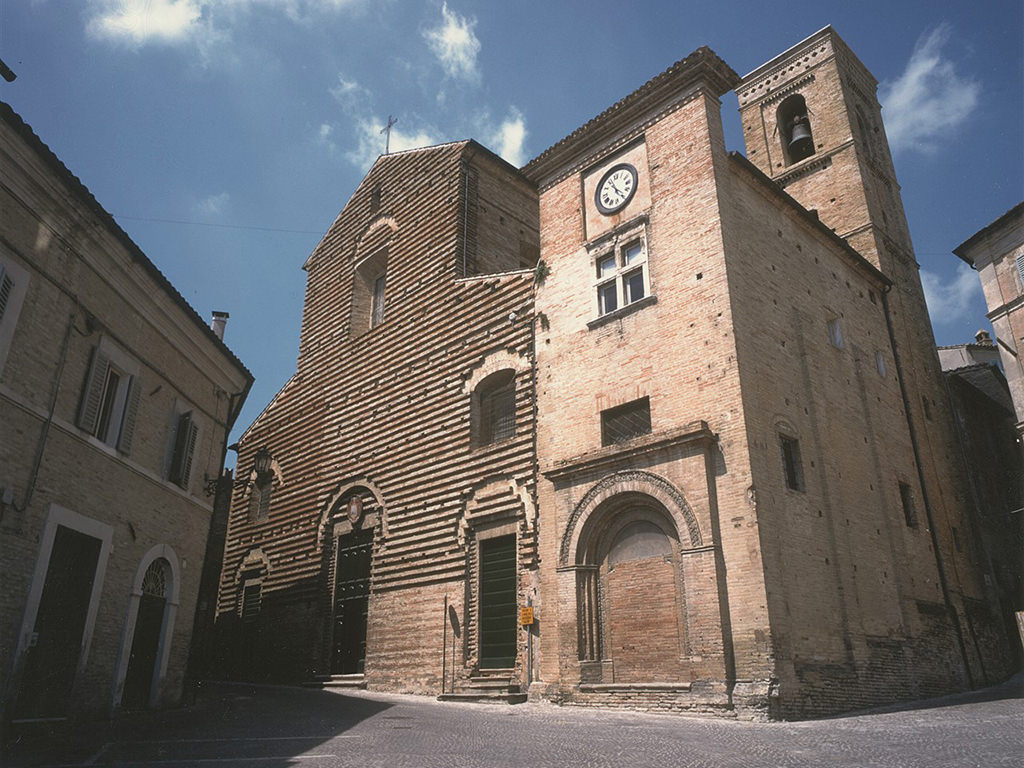
Church of Santa Maria in Piazza
Temporary closure due to earthquake damage
The church keeps inside the altarpiece by Lorenzo Lotto – The Madonna in Glory with Saints John the Baptist, Anthony of Padua, Mary Magdalene and Joseph. (Oil on canvas, 330 x 215 cm).
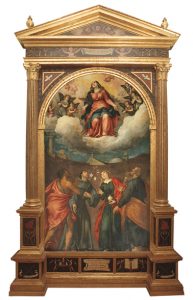
The presence of Saint Joseph and Saints John the Baptist, Mary Magdalene and Anthony expresses the Church’s intention to encourage the sacraments’ saving function which refers to the painted allegories. Saint John the Baptist represents the Baptism, Saint Anthony of Padua represents the Confirmation; Mary Magdalene the Extreme Unction and Joseph the sacrament of Marriage.
The four saint’s vision of the Virgin in her magnificence is placed in a space in the foreground which is welded with that of the background via a semi-circular wall beyond which ancient monuments are erected; the perspective layout of the monuments assumes a symbolic and historic virtue of the decline of the pagan world and the arrival of the new Christian era.
The work was commissioned in 1547 by the mayor of Mogliano, Jacomo Boninfante, at the price of 130 gold crowns to be paid in several installments, which also included the cost of the frame gilded wooden, built by Bartolomeo de San intaiador Cassano. The altarpiece was completed in 1548 and handed over to the community by the student Durante Nobili. The original frame is guarded in the adjoining sacristy.
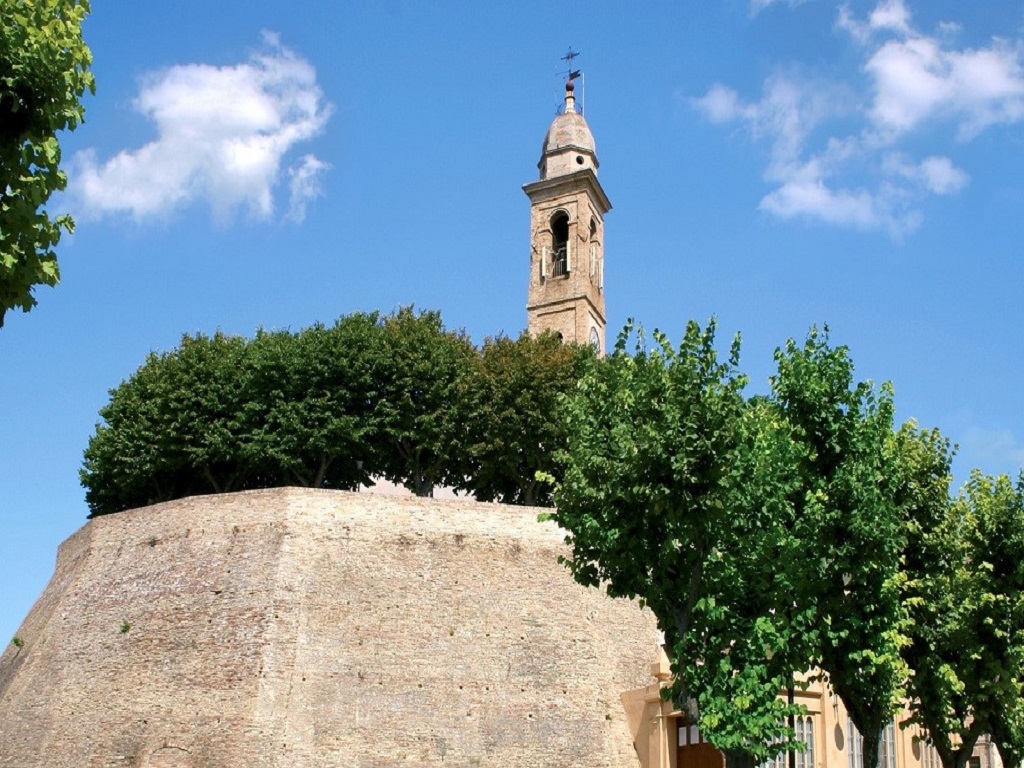
Rocca-medieval fortress
The medieval fortress, of which only the bastions remain, is the best place from which to admire the panorama; inside is the Church of Santa Maria del Suffragio, currently deconsecrated, built in 1698 and enlarged at the end of the 18th century.
From the fortress you can also admire the former St. Michael hospital built in 1782 and the Autopalace, a liberty style complex, a former coach garage, now restored and converted into an exhibition space.
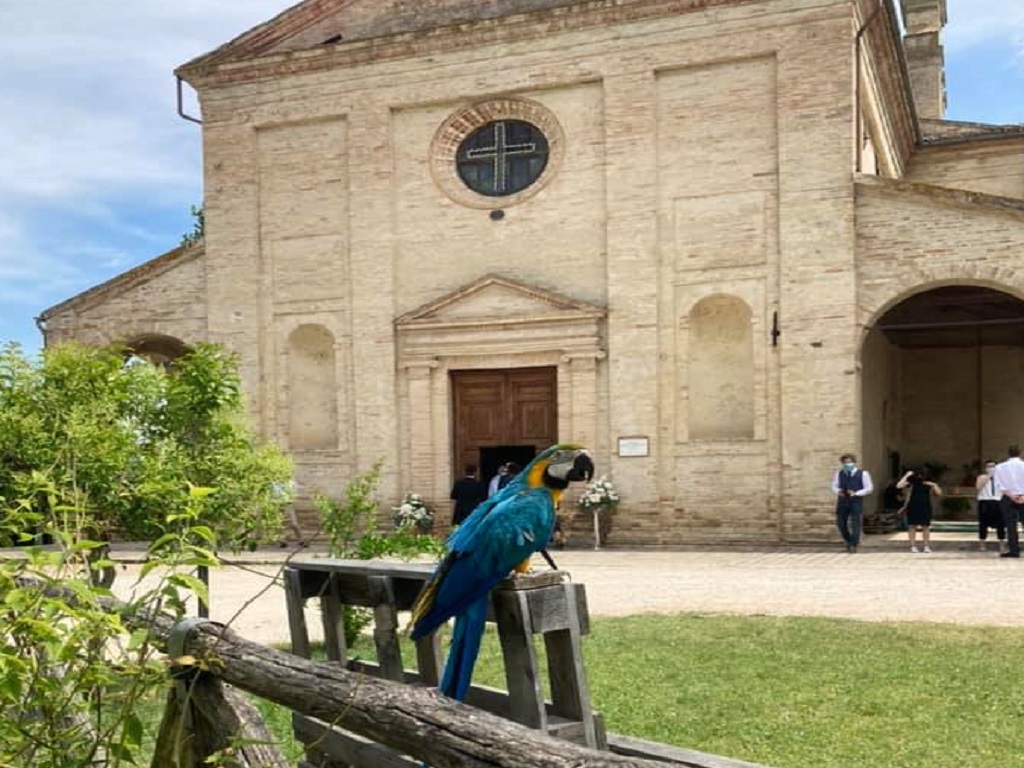
Church of the SS. Crocifisso d ‘Ete
It is located at the crossroads for Montegiorgio and Francavilla d’Ete, lapped by the river Ete Morto.
Building has started on 11 November 1579 the first stone was placed from the Bishop of Fermo Msgr. Pinelli, who chose the location. The government and the administration were attributed, with bull of Pope Gregory XIII, to the brotherhood of the SS. Sacramento, which still holds them.
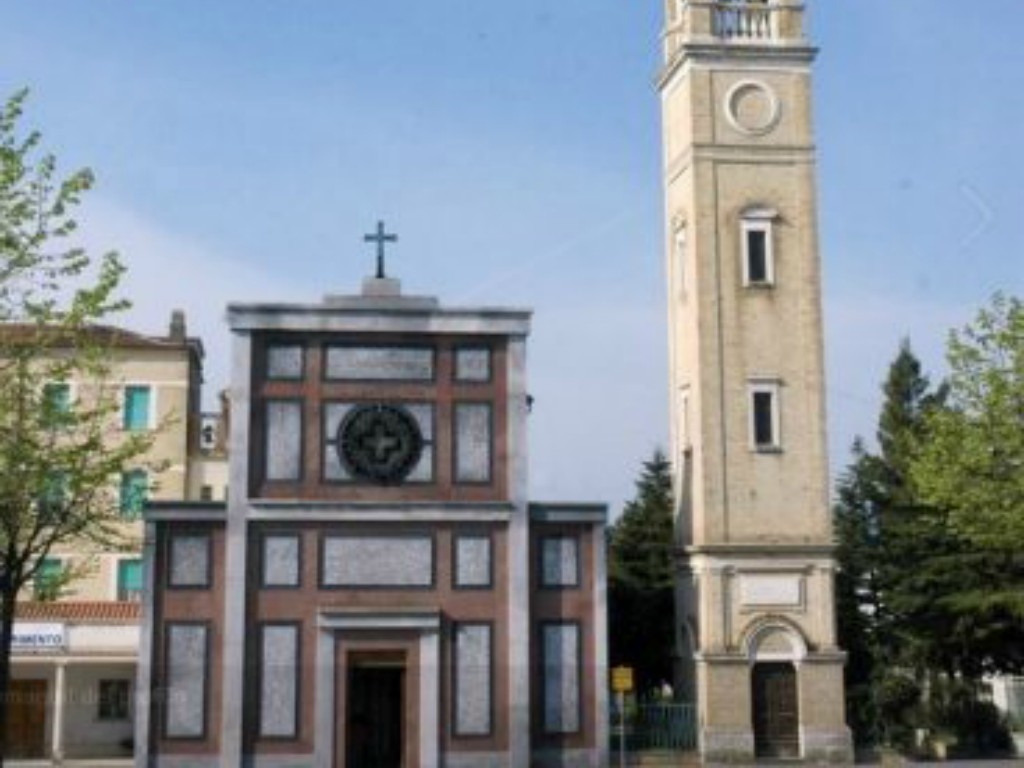
Sanctuary of the SS. Crocifisso
Here is venerated an image depicting ‘Crucified Christ that rises from the grave’ fresco at the end of 1400. Following a miraculous event that happened in the year 1809, the church, rebuilt in elegant neoclassical design by G. Lucatelli, was declared sanctuary by the Viceroy of Italy.
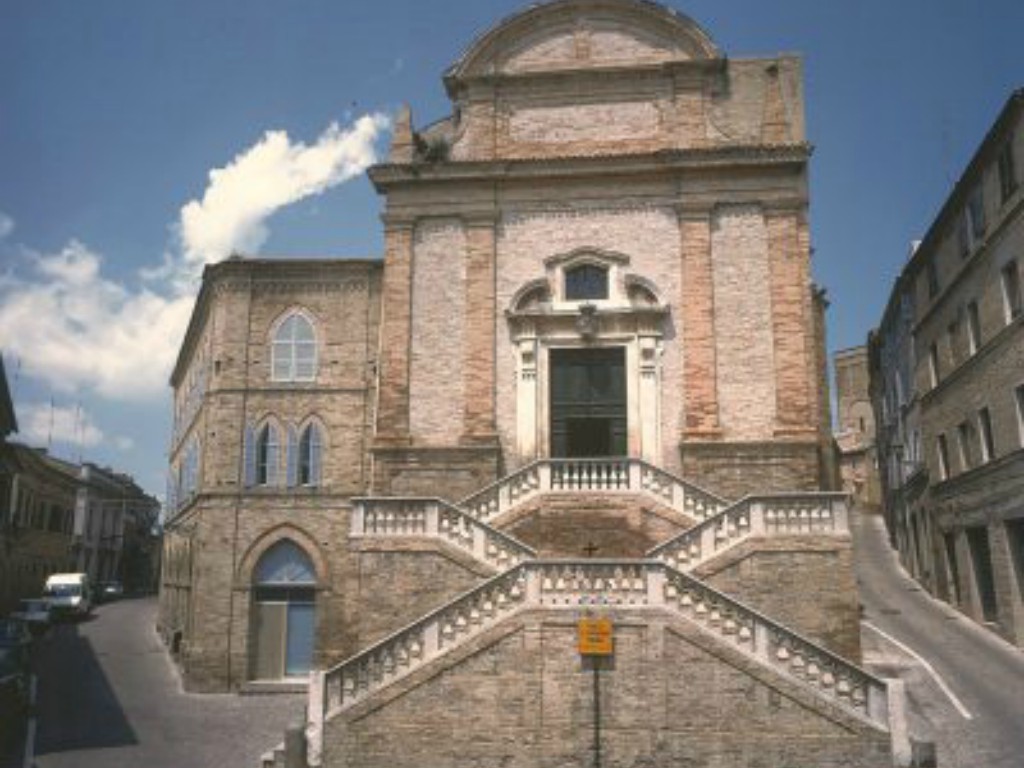
Church of San Gregorio Magno
Once ‘outside the city walls’ because it was built beyond the castle moat. This church has been transformed during the centuries , the last change was in the XVIII century when the church “was turned” (the presbytery was moved to the entrance side) and was added a monumental staircase to connect the entrance to the new roadway. Inside you can admire an altarpiece of Durante Nobili from Caldarola, a pupil of Lotto and an interesting picture of G.B. Fagiani depicting Mogliano as it appeared in the XVIII century.
Church of San Nicolò di Bari
Currently transformed into an auditorium. Once it stood near the keep: rebuilt twice, it was located a little lower than the old position. It is a small jewel of Baroque art. Above the altar, a scagliola work by Interlenghi di Montottone, a canvas by A. Ricci, the Last Supper; on the sides two paintings, Madonna with Child and Saints Nicola di Bari and Agata (left) and Beato Pietro da Mogliano and S. Antonio da Padova (right).
Monastery of San Giuseppe
Built in 1630 by the Benedectine Sisters of Cassino who remained there for about two centuries, in 1855 it was granted to the Sisters of San Giuseppe di Torino, who occupied it until 2018. The enclosed spaces are worthy of note, since the doors of the rooms are all painted with figures of saints in the upper part and landscapes in the lower one. The Church of the Saints is annexed to the monastery Grisogono and Benedetto, a precious rococo style environment, intact in its original structure and embellished with painted doors and windows, a coffered ceiling and an organ.
Santa Maria da Piedi
Set in the walls, next to the Levante gate, it took the name of Santa Maria “a pede castri”. The adjacent Gothic arch preserves the iron hinges of the doors which were closed at sunset after the tolling of the Ave Maria. On the ancient wall, above the arch, there are still five recesses of as many coats of arms that were removed by Napoleon’s soldiers after the battle of Tolentino (1797).
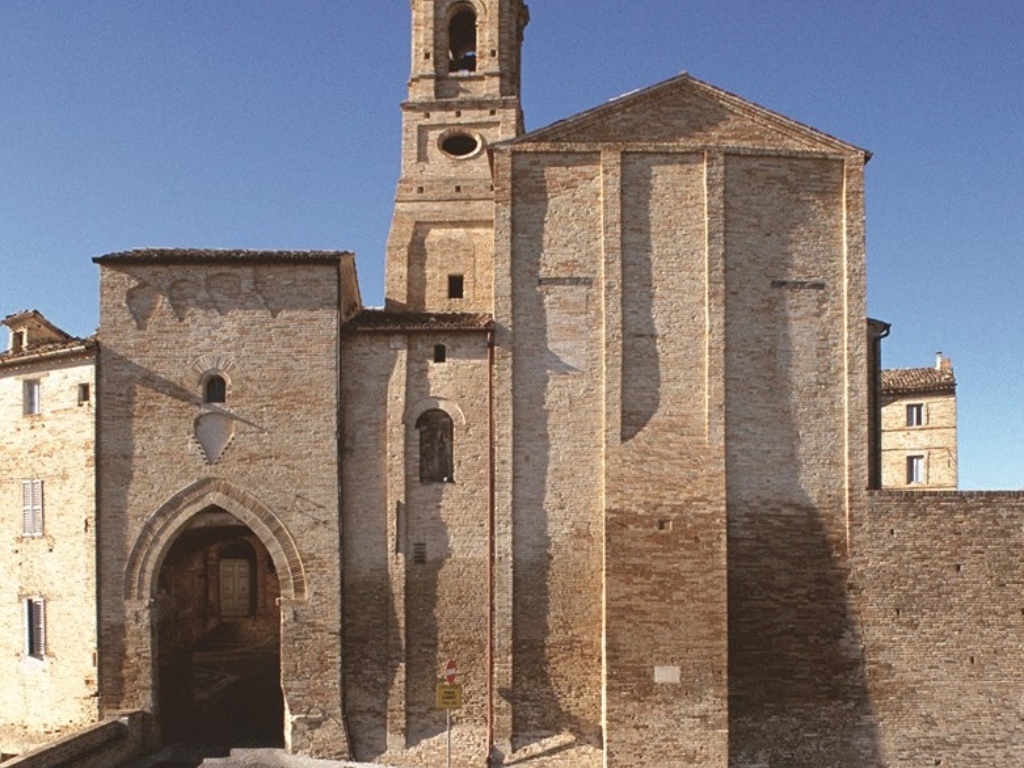
Medieval arch entrance
The gate formerly called “Porta da Piedi” (now called Porta Levante), represented the main entrance to the fortified city from the east.
Unfortunately, no documents have been found certifying the construction date. Its origin is presumably located in the fourteenth century as shown by the analysis of the arch and the particular symbolism found on it.
The “Porta da Piedi” was a tower entrance probably equipped with a protruding apparatus with corbels, machicolations and battlements, which no longer exist. What remains, however, is the pointed arch typical of Gothic architecture widespread between the twelfth century and the mid-fourteenth century.
The original appearance of the door is unfortunately strongly altered by the additions, such as the eighteenth-century one of the lowered arch vault to allow the static forces of the bell tower of the church of Santa Maria da Piedi to be discharged, and by the restorations that have gone on over the centuries. .
We still find the iron hinges of the doors that in the past everyday at sunset the door was closed when the bells rang.
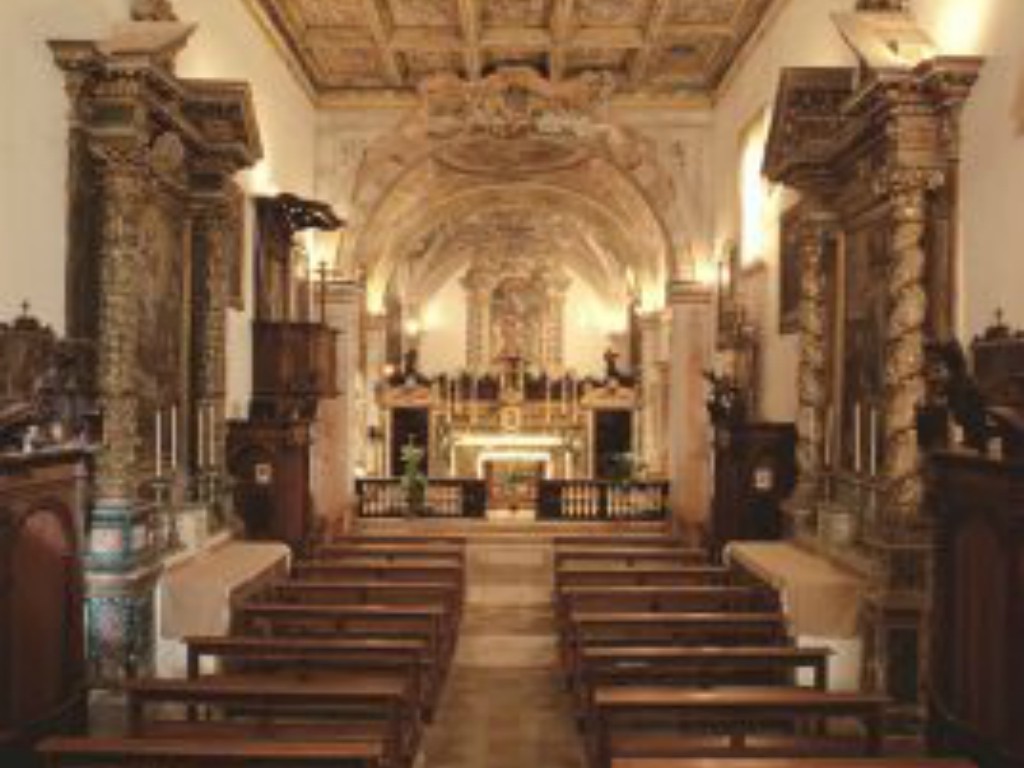
Church of Santa Colomba
The church has an evocative coffered ceiling painted by the Moglianese G.B. Pheasants between 1750-1752. Behind the altar, a valuable panel by Durante Nobili, an artist following Lotto: Enthroned Madonna with Child among Saints Joseph, Colomba, Giovanni Battista, Francesco d’Assisi and Benedetto (1554). The cloister is of considerable beauty, with its frescoed lunettes and wooden furnishings.
Church of Our Lady of the Good Heart
The church of the Madonna del Buon Cuore was built in 1778, thanks to the donations collected by the Observant Friars Minor who lived in the nearby convent of Santa Colomba. A miraculous image of the Madonna and Child was placed in the church.
In front of the altar there was a painting of a beautiful flight into Egypt, unfortunately later stolen.
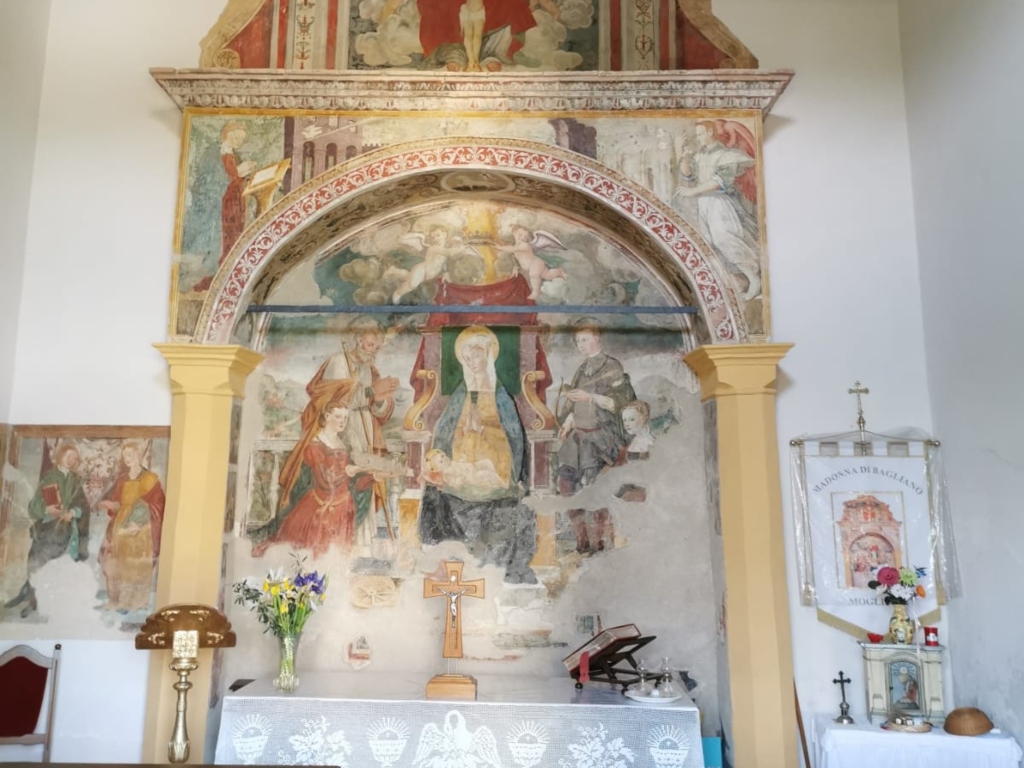
Church of St. Maria di Bagliano
The church of Santa Maria di Bagliano is located near the road to Massa Fermana and contains inside a fresco attributed to the school of the Venetian painter Carlo Crivelli where the Madonna enthroned with the Child is painted.
It was built in 1546 as it is written in some bricks placed on the facade, above the entrance door. It seems that previously existed in its place a votive shrine.
From 1608 it belonged to the brotherhood of the Concezione whose members, who celebrated the functions in the church of Santa Maria di Piazza, wore a white sack to which a white cape was added in 1783. In the coat of arms they bore the image of the owner.
We know that the altar was inaugurated in 1625 and Giuliano Bresciani established a benefit there and restored it in 1642.
The building has a sort of aedicule in the main altar with frescoes from the 15th-16th centuries, part of the Caldarolese area.
In the painting inside you can see the saints Giuseppe and Sebastiano and a woman to the left of the Madonna carrying the model of the castle and fortress of Mogliano in her hand.
Church of S. Grisogono
This territory in the Middle Ages consisted of the castles of Mogliano: the current historic center; Monte Ansone, near the district called Madonna della Neve; Poggio Santa Lucia, in the homonymous districts, and finally Montechiaro where there is the church of San Crisogono, from which the locality still takes its name today.
In the year 1097 it was donated by the counts Giberto, Trasmondo and Berardo, sons of Ismidone, to the abbey of S. Maria di Piobbico near Sarnano.
A privilege of Innocent IV of January 29, 1252 confirms the ownership of some Moglianese assets to the abbot of Piobbico, including our church. In 1299 the Abbot of Piobbico confirmed the rectors appointed by Ezzelino son of Count Gualtiero, who resided in Montechiaro as deduced in a document from the Curia of Fermo concerning the collection of tithes.
In the period of the struggles between the Papacy and the Empire, the Lords of Mogliano were loyal to one or the other faction. Several times they came into conflict with Fermo and ended up fighting bitterly: Mogliano was occupied by the Fermani and Montechiaro destroyed. We are at the time of Ezzelino da Mogliano, grandson of the more famous Fildesmido. The inhabitants of Montechiaro moved to the nearby castle of Mogliano which is safer because it is well fortified where, around 1323, they built the houses and, in all probability, the destroyed church of San Crisogono in the eastern district.
In 1631 a community of Benedictine nuns built their convent in the vicinity of the church, usurping its use to the parish priests, to the point that the Bishop of Fermo was forced to force the nuns to rebuild, in the ancient rural hamlet, the church for them. expenses. This happened in 1733.
Church of St. Maria del Suffragio, XVIII century
The confraternity of the Suffragio took charge from 1689 for the construction of the church; which was opened in 1702 and consecrated by the archbishop of Fermo Alessandro Borgia in May 1730.
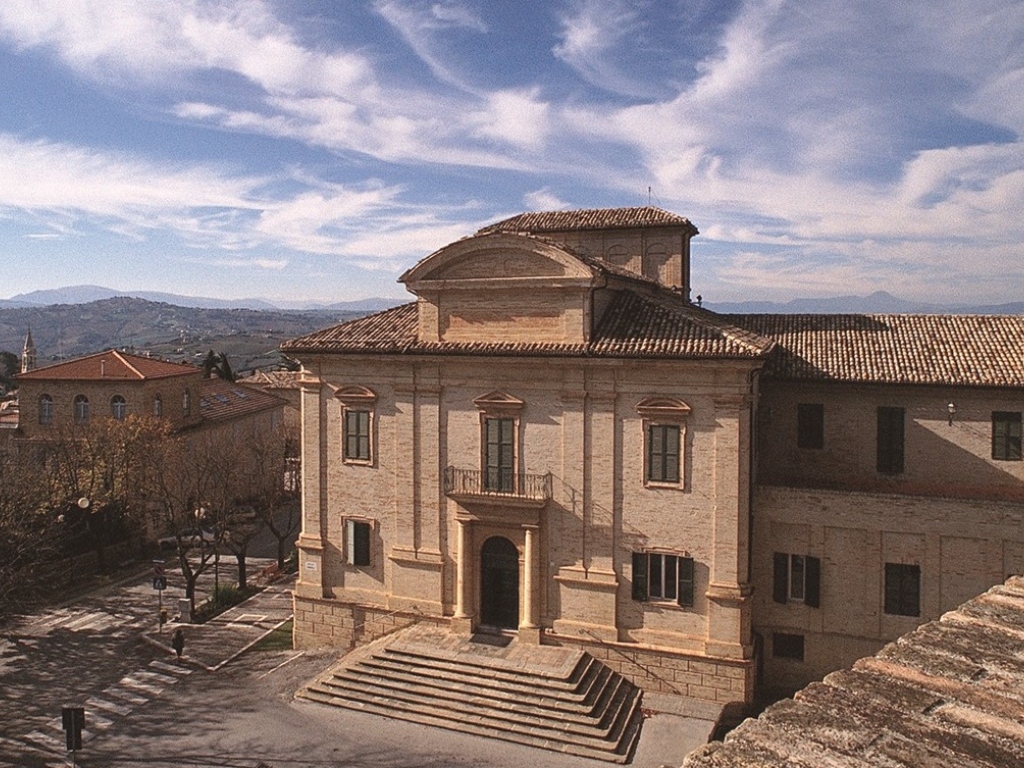
Former hospital of St. Michele
The earliest news of a hospital in Mogliano dates back to 1383 when Bonconte di Ruggero, grandson of Gentile da Mogliano, left 100 gold florins for its construction. It was necessary to wait until 1432 to see the first structure open, in a house in the square, by the will of Giovanni Blanchi.
A new hospital was erected outside the Porta Roma, in the place where there was a small church. The first stone was placed on 17 June 1776 and after some slowdowns and vicissitudes, it was completed in 1785.
The project seems to have been entrusted to Luigi Giannetti, while the control of the execution was entrusted to the noble Ermenegildo Chierichetti.
Inside, the upper floor retains its original appearance; the lower one, although modernized, was ennobled by an architecture that blends well with the ancient. In the large dormitory on the first floor you can admire two tempera paintings by Giambattista Fabiani from Moglianese, one depicting the Crucifix with the Adolorata, the other, in the ceiling, with Saint Joseph.

Bus terminus
Its history began in 1910 when the Caradonna & Bettucci company, which took over the bus service of Mogliano, Pausola and Macerata, asked the municipality of Mogliano for authorization to build an autopalace.
Only in 1912, precisely with a resolution of 1 March, the City Council authorized its construction and sold, reserving in the event of cessation of the activity, priority over the purchase of the property, the area and the sum of two thousand five hundred lire.
It also requires the company to grant a postal service for which it undertakes to pay the sum of four thousand lire annually.
The garage was built by the Giuseppe Salsiccia company, based on the design of the engineer Gaetano Caradonna. With a rectangular plan with a part carved into the walls of the fortress, has a length of fifteen meters and a width of four and a half meters. Entirely made of bricks plastered with polished cement left natural, it consists of two floors. The lower one, longer, used as a garage for bus, with a wide opening, suitable for vehicles, on both sides. The smaller upper floor, intended for office use, is flanked by two practicable terraces.
The garage is not an isolated element: with the most illustrious one in Macerata (by Cantalamessa), in Corridonia and in Macina di Mogliano (both by Caradonna), they attest to the birth and development of one of the first public transport lines in the Macerata area managed company SIAMP, then SIAMC. Today it is used as a room for meetings and public meetings.
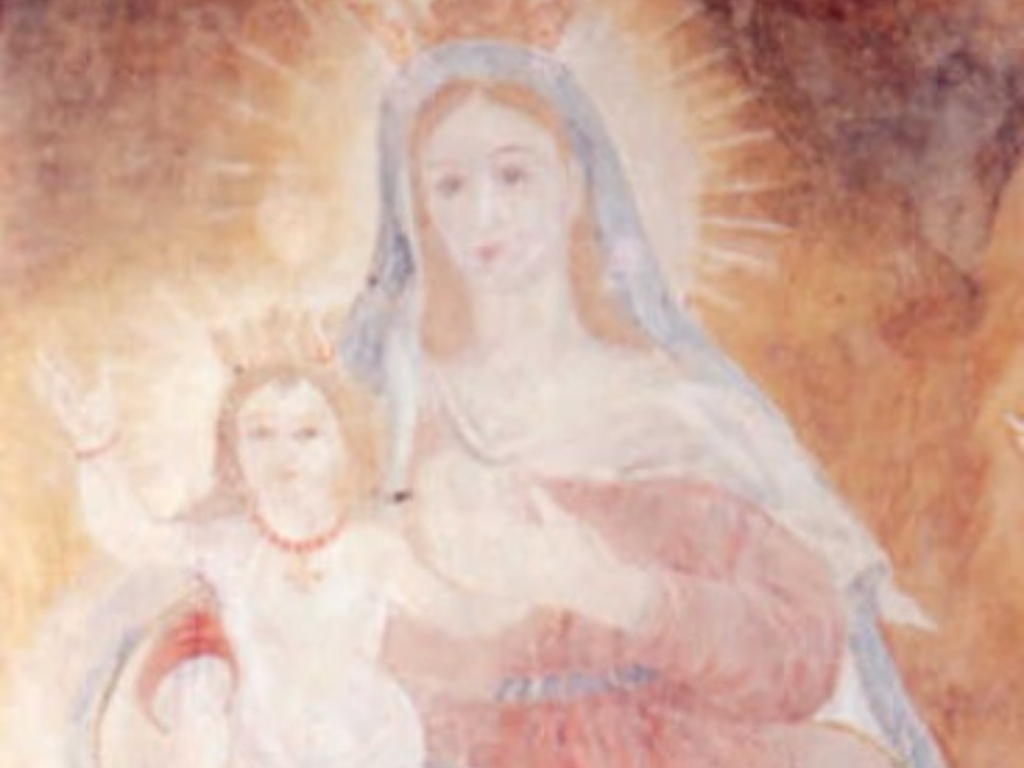
Church of Blessed Virgin of graces
“In a lovely corner in Contrada Prati Grandi , a stream flows under a row of poplar tree, and we find the small church of Beata Vergine delle Grazie known as the Madonna delli Prati from the name of the street” (F. Cornazzani).
Originally it was called S. Maria delle Moglie because it was built in a muddy area.
There are no news on its origins; the first certain news date back to 1683, the year when the City Council decided to fix a road, in Contrada Prati where a votive shrine stood with a painting considered miraculous.
According to the tradition, sick people were brought there to ask the Virgin Mary for miracles: they drank the water of the stream.
Thanks to the devotion of the inhabitants in Mogliano, a number of offers were collected, so that in 1757 the construction of a small church began in which the prodigious painting was placed.
In 1812 some unknown people sacked it and in 1817 the bell was stolen.
After many years in 1989, thanks to the kind charity of Mrs. Maria Teresa Andreozzi, it was restored and reopened to the inhabitants.
The interior is adorned with a single altar surmounted by the painting depicting the Virgin and Her Child , on the basis of the ancient painting.
On the left of the entrance there is a large stone slab which, according to the tradition, belongs to the demolished church of S. Michele in Templano.
Church of St Lucy
The oldest information on the construction dates back to the seventh century. In 1110 it was incorporated into the castle built in the local district, between Mogliano and Montolmo (Corridonia), called Poggio Santa Lucia. Over the centuries it has been restored several times, one of which was in 1616 documented by a recently restored old mural painting, which is thought to have been painted in 1619. The painting depicts the Virgin Mary with Child and Saints Lucia (on the right) and Carlo Borromeo. Among the valuable works found inside there is a seventeenth-century canvas with the image of the saint and a reliquary bust.
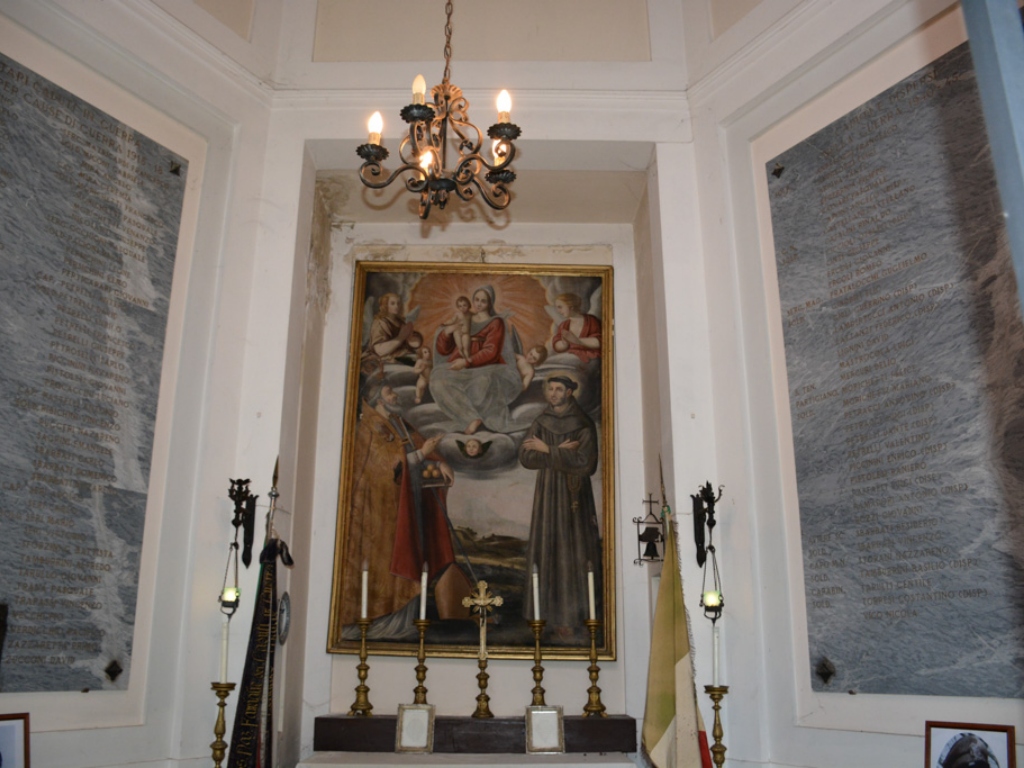
Temple of blessed Peter of Mogliano
In the 15th century in this area the victims of cholera were buried and a chapel was built dedicated to Virgin Mary. In the seventeenth century the chapel was widened and a large grave was created for the deceased affected by this disease.
The new temple took its name from Beato Pietro da Mogliano and decorated with paintings by Pierfrancesco Renulfus da Novara. It was called Madonna delle Scalelle or Pittura Grande by local people. In 1720 it was again enlarged and modified with decorations by the artist Mancini da Recanati and given to the local religious group named “Confraternita S. Nicolò” who would keep it for the future.
In 1920 for the events of the second centenary of the reconstruction and the fifth centenary of the birth of Beato Pietro it was total rebuilt on the basis of the project of the engineer Giuseppe Rossi from Fermo, thanks to the offers of Sebastiano Ferretti.
Outside, above the entrance, there is the inscription: “DULCE ET DECORUM EST PRO PATRIA MORI”. Inside, above the altar, a seventeenth-century painting can be admired, attributed to Vincenzo Latini, depicting Mary Immaculate with Beato Pietro da Mogliano; on the background you can see Mogliano as it appeared at the time. There are also plates with dedications and names of the Fallen under which a helmet, a water bottle and a bullet have been placed to symbolize the service offered by the soldiers dead in the war.
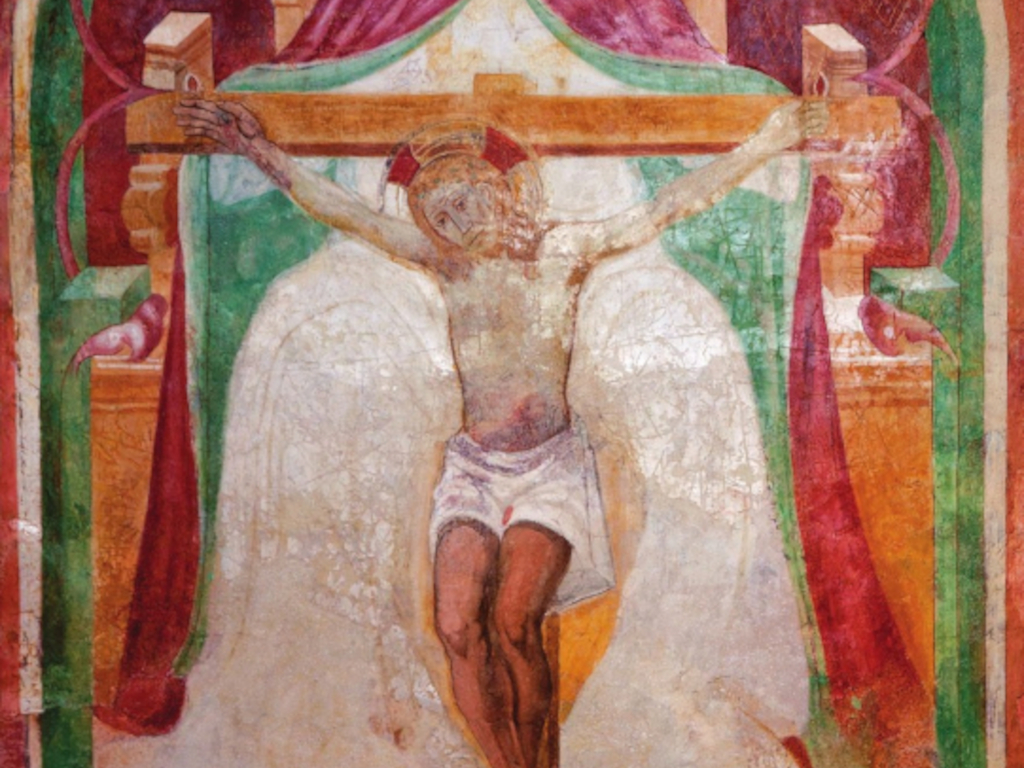
The Church Crocifisso d’Appresso
On a land owned by the Chierichetti family (a noble family from Mogliano), at the intersection of the road that goes to the church of the Crocifisso d’Ete, a chapel was built. On a wall, a fresco depicting the trinity, similar to a much older image in the church of the Crocifisso d’Ete, not far away in the Ete valley could have been seen. The chapel belonged to the Chierichettis, but the reason or the period of the construction are unknown. During the recent restoration some dates and names left by pilgrims to leave a sign of their presence have emerged. An engraved date, 1471, proves that the work dates back to an earlier period: before the construction of the chapel, the fresco was already the object of adoration by pilgrims.

